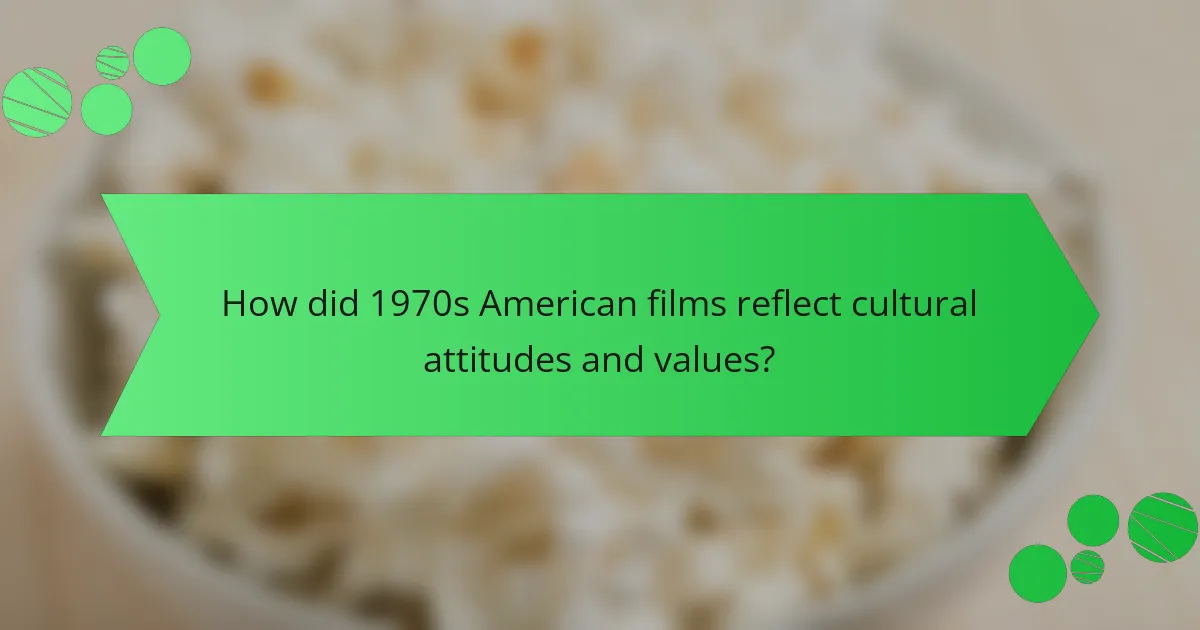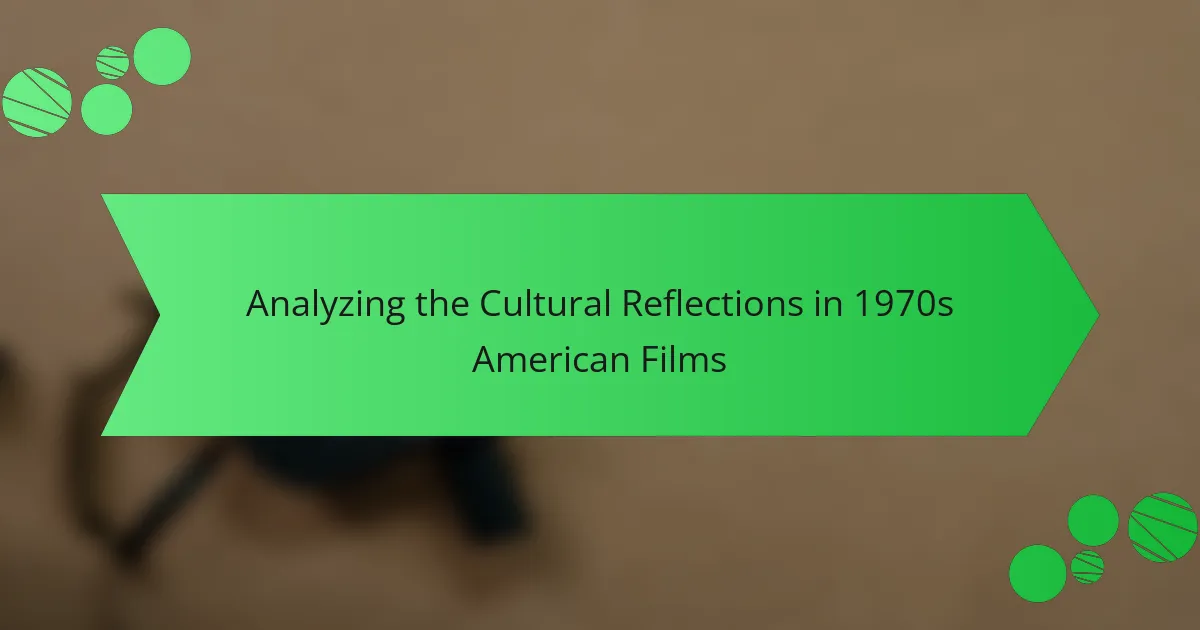
What are the key characteristics of 1970s American films?
1970s American films are characterized by their focus on realism, complex characters, and social issues. This era marked a shift from traditional storytelling to more nuanced narratives. Filmmakers often explored themes of disillusionment and rebellion. Notable films include “Taxi Driver” and “One Flew Over the Cuckoo’s Nest.” These films reflected societal changes and the counterculture movement. Directors like Martin Scorsese and Francis Ford Coppola emerged during this time. The use of anti-heroes became prevalent, challenging conventional moral standards. Additionally, the era saw the rise of independent cinema, breaking away from studio constraints.
How did societal changes influence film themes in the 1970s?
Societal changes significantly influenced film themes in the 1970s. The decade was marked by political upheaval, social movements, and economic challenges. Films began to reflect themes of disillusionment and skepticism towards authority. This shift was partly due to events like the Vietnam War and Watergate scandal. The rise of counterculture also inspired narratives centered on rebellion and individualism. Additionally, the feminist movement prompted films to explore gender roles and women’s rights. These societal influences shaped iconic films like “One Flew Over the Cuckoo’s Nest” and “Taxi Driver.” Overall, 1970s films served as a mirror to the evolving American society.
What major historical events shaped the narratives of this era?
The major historical events that shaped the narratives of the 1970s American films include the Vietnam War, the Watergate scandal, and the civil rights movement. The Vietnam War, which escalated in the 1960s and continued into the 1970s, influenced filmmakers to explore themes of disillusionment and conflict. The Watergate scandal, which led to President Nixon’s resignation in 1974, created a climate of distrust in government, reflected in films that critiqued authority. The civil rights movement, which gained momentum in the 1960s, inspired narratives focusing on social justice and racial equality. These events collectively shaped the cultural landscape, leading to films that questioned societal norms and depicted the complexities of American life during that era.
How did the counterculture movement manifest in film during the 1970s?
The counterculture movement manifested in film during the 1970s through themes of rebellion and social critique. Films often depicted anti-establishment sentiments and explored issues like drug use, [censured] liberation, and civil rights. Notable examples include “Easy Rider,” which showcased the disillusionment with American society. “The Graduate” reflected generational conflicts and the search for identity. “One Flew Over the Cuckoo’s Nest” critiqued institutional authority and conformity. These films resonated with audiences seeking alternatives to mainstream values. The portrayal of marginalized voices became prominent, challenging traditional narratives. Overall, the 1970s cinema captured the essence of a transformative cultural moment.
What cinematic techniques became prominent in the 1970s?
Cinematic techniques that became prominent in the 1970s include handheld camerawork, non-linear storytelling, and naturalistic lighting. Handheld camerawork created a sense of immediacy and realism. Films like “The French Connection” showcased this technique effectively. Non-linear storytelling became popularized by movies such as “Pulp Fiction.” This approach allowed for complex narratives and character development. Naturalistic lighting was used to enhance authenticity in films like “One Flew Over the Cuckoo’s Nest.” These techniques reflected the era’s cultural shifts and artistic experimentation.
How did directors innovate storytelling methods during this decade?
Directors innovated storytelling methods during this decade by embracing non-linear narratives and complex characters. They often used flashbacks and multiple perspectives to enrich the plot. Films like “Pulp Fiction” exemplified this approach with its fragmented timeline. Additionally, directors explored social issues through character-driven stories. Movies such as “One Flew Over the Cuckoo’s Nest” tackled mental health and institutional critique. The rise of anti-heroes in films reflected societal disillusionment. This decade also saw a shift towards realism, with directors incorporating documentary-style techniques. These innovations reshaped audience expectations and influenced future filmmaking.
What role did cinematography play in reflecting cultural themes?
Cinematography played a crucial role in reflecting cultural themes in 1970s American films. It visually captured the societal changes and tensions of the era. Techniques such as lighting, framing, and camera movement were used to convey emotions and themes. For instance, the use of darker tones often symbolized disillusionment. Iconic films like “Taxi Driver” utilized close-ups to portray isolation and alienation. Wide shots in “Easy Rider” represented the quest for freedom and exploration. Cinematography helped to establish a connection between the audience and the cultural context. This visual storytelling made the themes more relatable and impactful.

How did 1970s American films reflect cultural attitudes and values?
1970s American films reflected cultural attitudes and values through themes of disillusionment and social change. The decade followed the tumultuous 1960s, marked by the Vietnam War and civil rights movements. Films like “Easy Rider” and “One Flew Over the Cuckoo’s Nest” depicted countercultural sentiments and critiques of authority. The portrayal of antiheroes became common, showcasing a shift away from traditional values. Additionally, the rise of independent cinema allowed diverse voices to emerge. Movies addressed issues such as feminism, environmentalism, and racial tensions. This era’s films often mirrored societal struggles, emphasizing realism over escapism. The cultural landscape of the 1970s was thus deeply intertwined with the narratives presented on screen.
What were the prevalent social issues depicted in films of the 1970s?
Films of the 1970s depicted several prevalent social issues. Key themes included civil rights, anti-war sentiments, and feminism. The civil rights movement was highlighted through narratives addressing racial inequality. Anti-Vietnam War films reflected public disillusionment with government policies. Feminism gained prominence in films exploring women’s rights and gender roles. Additionally, urban decay and economic struggles were common backdrops in many stories. These films often served as a mirror to the societal changes occurring during the decade. Notable examples include “One Flew Over the Cuckoo’s Nest” and “The Godfather,” which addressed these pressing social issues.
How did films address topics such as race, gender, and class?
Films in the 1970s addressed race, gender, and class through narrative and character representation. They often highlighted social injustices and challenged stereotypes. For example, “Guess Who’s Coming to Dinner” tackled interracial relationships amid societal tensions. “Thelma & Louise” explored female empowerment and liberation. Documentaries like “Harlan County, USA” examined class struggles and labor rights. These films reflected the era’s cultural shifts and sparked conversations about identity and equality. The portrayal of marginalized groups became more prominent, influencing public perception and discourse.
What impact did the Vietnam War have on film narratives?
The Vietnam War significantly impacted film narratives by introducing themes of disillusionment and moral ambiguity. Films began to reflect the complexities of war and the psychological effects on soldiers. Examples include “Apocalypse Now” and “Platoon,” which depicted the chaos and brutality of combat. These narratives often challenged traditional heroic portrayals of war. They highlighted the struggles of veterans reintegrating into society. The war also influenced storytelling techniques, utilizing non-linear narratives and surreal imagery. This shift marked a departure from earlier, more patriotic war films. Overall, the Vietnam War reshaped American cinema by fostering critical perspectives on conflict.
In what ways did the portrayal of American identity evolve in this decade?
The portrayal of American identity evolved significantly in the 1970s. This decade saw a shift from idealized representations to more complex, nuanced characters. Films began to reflect social issues such as civil rights, gender equality, and Vietnam War consequences. The rise of anti-heroes in cinema showcased a departure from traditional heroic figures. Movies like “One Flew Over the Cuckoo’s Nest” and “Taxi Driver” highlighted individual struggles against societal norms. These films often depicted disillusionment with the American Dream. The emergence of independent cinema allowed diverse voices to challenge mainstream narratives. Overall, the 1970s marked a critical transformation in how American identity was represented in film.
How did films challenge traditional notions of heroism and morality?
Films in the 1970s challenged traditional notions of heroism and morality by presenting complex characters. These characters often displayed flaws and moral ambiguity. For example, anti-heroes became prominent in films like “Taxi Driver” and “The Godfather.” These films depicted protagonists who did not fit the classic heroic mold. Instead, they struggled with personal demons and societal issues. This shift reflected a more realistic portrayal of human nature. Additionally, films questioned authority and traditional values. They often showcased the consequences of violence and corruption. This era marked a significant departure from idealized heroes, emphasizing realism and moral complexity.
What role did anti-establishment sentiments play in character development?
Anti-establishment sentiments significantly influenced character development in 1970s American films. These sentiments often drove characters to challenge societal norms and authority figures. Protagonists frequently embodied rebellion against government, corporations, or traditional values. This rebellion resonated with audiences disillusioned by political scandals and social upheaval. Films like “Easy Rider” and “One Flew Over the Cuckoo’s Nest” showcased characters who rejected conformity. Their struggles highlighted the conflict between individual freedom and societal constraints. This dynamic added depth to character arcs, making them relatable and compelling. The portrayal of anti-establishment themes reflected broader cultural shifts during the era.
![]()
What are some iconic films from the 1970s that exemplify cultural reflections?
Some iconic films from the 1970s that exemplify cultural reflections include “The Godfather,” “Taxi Driver,” and “One Flew Over the Cuckoo’s Nest.” “The Godfather” explores themes of power and family dynamics in post-war America. It reflects societal issues such as organized crime and the American Dream. “Taxi Driver” delves into urban alienation and mental health, showcasing the struggles of a Vietnam War veteran. This film mirrors the disillusionment prevalent in American society during the 1970s. “One Flew Over the Cuckoo’s Nest” critiques mental health institutions and societal norms. It highlights themes of individuality versus conformity, resonating with the countercultural movements of the era. Each of these films serves as a lens through which the cultural landscape of the 1970s can be examined.
Which films are considered cultural touchstones of the 1970s?
Films considered cultural touchstones of the 1970s include “The Godfather,” “One Flew Over the Cuckoo’s Nest,” and “Taxi Driver.” “The Godfather,” released in 1972, is a landmark in American cinema. It explores themes of power and family within the Mafia context. “One Flew Over the Cuckoo’s Nest,” released in 1975, critiques mental health institutions and authority. It won five Academy Awards, reinforcing its impact. “Taxi Driver,” released in 1976, reflects urban alienation and societal decay. It features the iconic line, “You talkin’ to me?” These films collectively represent significant cultural and social issues of the era.
What themes do these films share that reflect the era’s cultural landscape?
The films of the 1970s share themes of disillusionment, social upheaval, and individualism. Disillusionment is evident as characters confront the failures of authority and the American Dream. Social upheaval reflects the era’s political tensions, including civil rights movements and anti-war sentiments. Individualism is portrayed through protagonists who challenge societal norms and seek personal freedom. These themes resonate with the cultural landscape marked by a questioning of traditional values and a desire for change during the turbulent decade. The Watergate scandal and Vietnam War significantly influenced these narratives, showcasing the public’s loss of trust in government and institutions.
How did these films influence future generations of filmmakers?
1970s American films significantly influenced future generations of filmmakers by introducing innovative storytelling techniques. These films often embraced realism and complex characters, setting a new standard for narrative depth. Directors like Martin Scorsese and Francis Ford Coppola showcased character-driven plots that resonated emotionally with audiences. Their work inspired filmmakers to prioritize character development over traditional plot structures. Additionally, the era’s experimentation with cinematography and editing techniques paved the way for visual storytelling advancements. The use of natural lighting and handheld cameras became more prevalent, influencing the visual style of future films. The thematic exploration of social issues in these films encouraged later filmmakers to tackle complex subjects. This legacy of bold storytelling continues to shape modern cinema.
How can understanding 1970s films enhance our view of contemporary culture?
Understanding 1970s films enhances our view of contemporary culture by revealing historical social dynamics. These films often addressed issues like feminism, civil rights, and anti-establishment sentiments. For example, “One Flew Over the Cuckoo’s Nest” challenged authority and mental health stigmas, reflecting societal tensions. Films like “Taxi Driver” explored urban alienation and violence, themes still relevant today. Moreover, the era’s cinematic techniques influenced modern storytelling and filmmaking styles. Understanding these films provides context for current cultural conversations and societal norms. This connection helps us comprehend how past narratives shape present ideologies.
What lessons can modern filmmakers learn from the 1970s cinematic landscape?
Modern filmmakers can learn the importance of authenticity and risk-taking from the 1970s cinematic landscape. The 1970s was a time of significant artistic freedom in Hollywood. Filmmakers like Martin Scorsese and Francis Ford Coppola pushed boundaries with their storytelling. They focused on character-driven narratives that reflected societal issues. This era produced films like “Taxi Driver” and “The Godfather,” which explored complex themes. The success of these films showed that audiences appreciate depth and realism. Additionally, the 1970s emphasized the value of innovative cinematography and sound design. Techniques from that era, such as natural lighting and location shooting, remain influential today. Embracing these lessons can help modern filmmakers create impactful and resonant works.
What are the best practices for analyzing cultural reflections in films today?
Best practices for analyzing cultural reflections in films today include a multi-faceted approach. First, contextualize the film within its historical and social background. This helps to understand the cultural influences at the time of its release. Second, examine the characters and narratives for representations of societal norms and values. Analyze how these elements reflect or challenge the culture of the era. Third, utilize critical theories such as feminism, post-colonialism, or Marxism to deepen the analysis. These frameworks provide different lenses through which to interpret the film’s cultural significance. Fourth, engage with audience reception studies to gauge how viewers interpret cultural messages. Research shows that audience reactions can vary widely based on personal and cultural backgrounds. Lastly, compare films across different periods to identify shifts in cultural reflections. This comparative analysis reveals evolving societal attitudes and beliefs. These practices collectively enhance the understanding of cultural reflections in films.
The main entity of this article is 1970s American films, which are characterized by their focus on realism, complex characters, and social issues. The article analyzes how societal changes, such as the Vietnam War and the civil rights movement, influenced film themes and narratives during this decade. It highlights the emergence of anti-heroes, innovative cinematic techniques, and the portrayal of marginalized voices, reflecting a shift in cultural attitudes and values. Additionally, the article discusses how these films challenged traditional notions of heroism and morality, and their lasting impact on contemporary cinema and cultural discourse.
